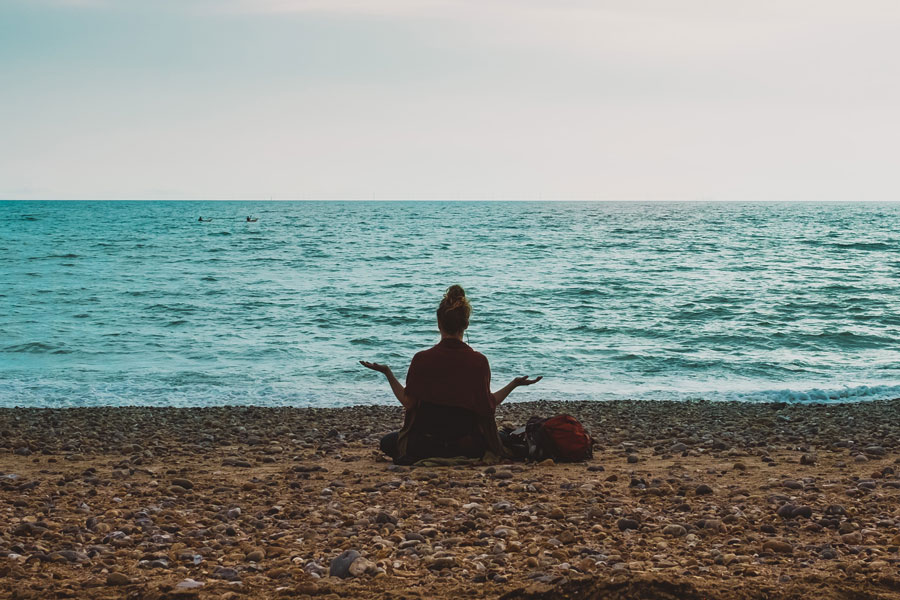
In our modern era, it appears that stress and overwhelm have become a normalized baseline for most people.
When we were younger, the majority of us probably received a particular roadmap for success.
If you worked really hard, got into a good college, and found a good job that paid you well with benefits, you would win the metaphorical game of life.
Why is it that so many of us that have followed this particular roadmap don’t feel like winners?
We were given a recipe to help us master our external success, yet very few of us were probably given a manual to learn to attune to and care for our inner world.
With the proliferation and increased popularity of self-help and spiritual development, you may have heard of the term self-care before, but you may not have heard of the term self-regulation.
To self-regulate means that we have the knowledge, ability, and skill to manage our inner environment and return to an inner sense of balance and homeostasis.
Self-regulation also means we have a certain level of reliance and trust in our ability to care for ourselves and know what we need no matter how complex and challenging life might get.
There is no ‘one,’ right way to self-regulate.
Self-regulation may look very different from person-to-person because we all have such unique and individual needs.
When we have reached the point of stress, overwhelm or burnout, this is a good indication that we probably haven’t created the space and time to care for ourselves in the way that most serves us.
What self-regulation empowers us to do is to develop the awareness of what our personal homeostasis looks and feels like, and more aptly discern when we are beginning to drift from our established baseline and balance point.
Through self-regulation, we can develop skills and habits that support us to resource ourselves in the moment.
So how does one begin to develop their capacity to self-regulate?
Depending on what we need, self-regulation might take the form of physical activity or a more internal activity.
Our ability to self-regulate is supported by the degree to which we are self-aware.
One way we can begin to cultivate self-awareness is to begin to track the sensations that are happening in our bodies.
The sensations we are experiencing in our bodies usually indicate how we are feeling on a deeper level.
When we are stressed, overwhelmed, or in pain, our bodies are going to be more physiologically activated and oriented towards defending and protecting us.
Whereas, when we are in a more relaxed state, we are more oriented towards nourishment, pleasure, openness, connectivity, and receiving.
Our bodies will always tell us exactly what we need.
The more that we learn to listen and pick up on our bodies’ subtle cues, the greater our capacity grows to know how to best care for ourselves in any given moment.
One practice that I like to give my clients is to track how their bodies contract and expand throughout the day.
When we are in a state of contraction, we are most likely in the grips of an experience that doesn’t feel nourishing and might even feel threatening to us.
We may even feel disconnected from ourselves and sense of truth in the moment.
When our bodies are in a state of expansion, this usually indicates we feel safe, regulated, resourced and connected to ourselves.
Self-regulation supports us in coming back into connection with ourselves so that we feel safe to healthfully interface with the world.
Through self-regulation, we become empowered to trust ourselves more.
Once we have cultivated self-awareness of our bodies and have a sense of what makes us contract and expand, we can then begin to tune into what our underlying needs might be.
There are many things that we can do to practically self-regulate in the moment.
One way to begin initiating self-regulation is to check in and see if you are connected to yourself.
If you are disconnected, you might ask yourself, “what might help me to feel safe in this moment?” “What might even feel good or nourishing for me to do right now?”
Another powerful and simple self-regulation technique is to pay attention to your breath.
Tracking our breathing patterns throughout the day can both support us in staying connected to our bodies, and in connection with our physical environment.
If you notice that you aren’t taking a full breath, you can begin to slow down your inhale and exhale and slowly expand your breath until it fills out your belly.
You might ask yourself, “what, if anything, has shifted in my experience in the slowing down of my breath?”
Making physical contact with ourselves is also a really incredible way to self-regulate.
Slowing your breath while placing a hand on your belly and another on your heart can help you to re-establish the connection to yourself and inner environment.
Physical movement, in general, can be very powerful for self-regulation.
If we create the space to slow down and listen, our bodies will usually communicate the exact way they need to move in order for us to feel good.
Whether it’s going to the gym, dancing, jumping up and down, rolling around on the floor, or giving ourselves a few moments to rest and breathe, we have a variety of options in the moment to care for ourselves and come back to our sense of center.
Lastly, but certainly not least, you might be wondering if there are other ways to self-regulate that aren’t necessarily physical or movement oriented.
Creating an ongoing relationship with our inner emotional world can be a potent vehicle for our self-regulating capacity.
When we have emotions that arise, we can learn to orient towards noticing them and welcoming them into our experience rather than ignoring and suppressing them.
The more we learn to welcome and name our feelings in the moment, the less energy and emotion get stuck in the nervous system.
As our energies and emotions are empowered to freely flow, the greater our capacity becomes to stay connected to ourselves and “in-flow” with our lives.
Self-regulation is one of the highest forms of self-care and self-love that we can engage in.
It is a potent practice that can dynamically shift our relationship with ourselves and the larger world.
Through self-regulation, we become more skillful in navigating the trials and tribulations of the human experience.
As we learn to attune to and meet our needs for care, nurturing, and self-connection, we begin to fill our proverbial cups.
As we commit to nurturing our connection to ourselves and intrinsic wholeness, we become more available for the things that make us feel most impassioned and radically alive, and the people we love the most.



??
You are 100% right. Through self-regulation, we become more skillful in navigating the trials and tribulations of the human experience.